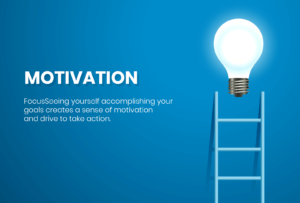Shaping your future is not just waiting to see what happens, but actively working towards achieving success in life. By taking control of your future, you create opportunities for achieving your goals and dreams. In this article, we will explore five simple yet powerful techniques that can empower you to shape your future and steer it towards success.
The 5 simple techniques we will discuss are:
- Setting clear and powerful goals
- Cultivating a positive mindset for success
- Managing your time effectively for maximum productivity
- Embracing failure and learning from setbacks
- Never stopping learning: The key to continued growth and success
Each of these techniques plays an important role in equipping you with the mindset, tools, and strategies necessary for creating a successful future. Let’s start this journey together as we discover the steps you can take to live a rewarding and fulfilling life.
1. Set Clear and Powerful Goals
Setting goals is a fundamental step in achieving success. By defining what you want to accomplish, you create a roadmap for your future. Here are some key points to consider when setting clear and powerful goals:
1.1. Identify Your Priorities
To set effective goals, it’s essential to align them with your core values and priorities. When your goals are in harmony with what truly matters to you, they become more meaningful and motivating.
Take some time for self-reflection and ask yourself what aspects of life are most important to you. Is it your career, relationships, personal growth, or something else? Consider the following steps:
- Make a list of your core values: These are the guiding principles that govern your decisions and actions.
- Reflect on your current priorities: Evaluate how you spend your time and energy. Are these aligned with your core values?
- Identify areas for improvement: Determine which areas of your life need more attention and where you want to make progress.
By identifying your priorities, you can focus on setting goals that will bring you closer to the life you desire.
1.2. Make Your Goals Measurable and Actionable
Once you have identified your priorities, it’s crucial to make your goals specific and measurable. Vague goals lack clarity and make it difficult to track progress. On the other hand, measurable goals provide a clear target and enable you to evaluate your achievements.
Consider the following example:
- Vague goal: “I want to improve my fitness.”
- Measurable goal: “I want to run a 5K race within six months.”
The measurable goal provides a specific target (running a 5K race) within a defined timeframe (six months). It allows you to track your progress by measuring factors such as distance covered and time taken.
To make your goals actionable, break them down into smaller steps or milestones. This makes them more manageable and gives you a sense of progress along the way. For example, if your goal is to start a business, you could set milestones such as conducting market research, creating a business plan, and launching your product or service.
By setting measurable and actionable goals, you create a clear path toward success and increase your chances of achieving them.
Remember, the key to setting clear and powerful goals is aligning them with your priorities and making them measurable and actionable. By doing so, you will have a roadmap that guides your actions and propels you towards success.
1.2. Make Your Goals Measurable and Actionable
When it comes to setting goals for your future success, having a clear direction to work towards is essential. One effective method for establishing actionable and achievable objectives is through the concept of SMART goals – Specific, Measurable, Achievable, Relevant, and Time-bound.
By making your goals specific and measurable, you increase the likelihood of achieving them. For example, instead of setting a vague goal such as “I want to lose weight,” you could reframe it into a measurable objective like “I aim to lose 10 pounds in the next two months by exercising three times a week and following a balanced diet.”
Here are practical tips for setting SMART goals:
- Write them down: Putting your goals on paper gives them a tangible form and reinforces your commitment to achieving them.
- Break them into smaller milestones: Divide your larger goals into smaller, manageable tasks or milestones to track your progress effectively.
- Set deadlines: Establishing time-bound targets creates a sense of urgency and helps prevent procrastination.
Incorporating these strategies into your goal-setting process can significantly enhance your ability to turn aspirations into tangible accomplishments.
2. Foster a Positive Mindset for Success
A positive mindset is crucial for achieving success in any endeavor. It helps you stay motivated, overcome challenges, and maintain resilience in the face of setbacks. Cultivating optimism and resilience can significantly impact your ability to navigate through life’s ups and downs. Here are some strategies to foster a positive mindset:
2.1. Cultivate Optimism and Resilience
- Practice gratitude: Take a moment each day to reflect on the things you are grateful for. This simple exercise shifts your focus from what’s going wrong to what’s going right in your life. It can help you appreciate the small joys and blessings, leading to an overall positive outlook.
- Surround yourself with positivity: Surrounding yourself with positive influences can have a profound impact on your mindset. Seek out individuals who uplift and inspire you, whether it’s through personal relationships or motivational content like books, podcasts, or videos.
- Challenge negative thoughts: Negative thoughts can quickly spiral and impact your mindset. When you catch yourself thinking negatively, challenge those thoughts by asking yourself if they are based on facts or assumptions. Replace negative thoughts with positive affirmations or realistic perspectives.
- Focus on solutions: Instead of dwelling on problems, shift your focus towards finding solutions. This proactive approach empowers you to take control of the situation and move forward. Break down complex problems into smaller, manageable steps, and celebrate each milestone along the way.
- Learn from failures: Failure is inevitable on the path to success. Instead of viewing failure as a setback, see it as an opportunity for growth and learning. Embrace failures as valuable lessons that provide insights into what works and what doesn’t. By adopting this growth mindset, you become more resilient and better equipped to handle future challenges.
2.2. Harness the Power of Affirmations and Visualization
- Use positive affirmations: Affirmations are powerful statements that help rewire your subconscious mind. By repeating positive affirmations, such as “I am capable of achieving my goals” or “I have the skills and knowledge to succeed,” you reinforce beliefs in your abilities. Write down affirmations that resonate with you and recite them daily to boost your confidence and motivation.
- Visualize success: Visualization is a technique used by many successful individuals to create a mental image of their desired outcomes. Close your eyes and vividly imagine yourself achieving your goals. Visualize the steps you need to take, the obstacles you might face, and how you will overcome them. This exercise strengthens your belief in your capabilities and helps align your actions with your vision.
Developing a positive mindset takes time and practice. Be patient with yourself as you work on cultivating optimism and resilience. Remember, success is not just about achieving specific outcomes; it’s also about embracing the journey and maintaining a positive attitude throughout.
By fostering a positive mindset, you create a strong foundation for success in all areas of your life. It allows you to approach challenges with determination, bounce back from setbacks, and stay focused on your goals. Embrace positivity as a driving force in your pursuit of success.
2.2. Harness the Power of Affirmations and Visualization
How Your Mindset Can Impact Your Success
Your mindset plays a crucial role in determining your success. It can either support you or hold you back on your journey towards achieving your goals. Having a positive mindset is essential for developing the resilience, self-confidence, and self-belief necessary to overcome obstacles and keep moving forward.
Overcoming Negative Thought Patterns with a Positive Mindset
Negative thought patterns can be detrimental to your progress. They often stem from fear, self-doubt, or limiting beliefs that create barriers in your mind. However, with a positive mindset approach, you can challenge and overcome these negative thoughts. Here are some common negative thought patterns and how to reframe them:
- Self-Doubt: Instead of thinking “I can’t do it,” replace it with “I am capable and confident in my abilities.”
- Fear of Failure: Shift your perspective from seeing failure as a setback to viewing it as an opportunity for growth and learning.
- Comparison: Rather than comparing yourself to others, focus on your own progress and celebrate small victories along the way.
The Power of Affirmations in Cultivating a Positive Mindset
Positive affirmations are powerful tools for rewiring your thoughts and cultivating a positive mindset. These are statements that reflect the qualities or outcomes you desire and are repeated consistently to reinforce positive beliefs. By incorporating affirmations into your daily routine, you can:
- Challenge negative self-talk and replace it with empowering messages
- Boost your self-confidence and belief in your abilities
- Create a positive mental environment that supports your goals
The Role of Visualization in Achieving Success
Visualization is a technique that involves creating vivid mental images of achieving your goals. By visualizing success, you activate the same brain regions as when you actually experience it, strengthening neural pathways associated with your desired outcomes. Here’s how visualization can benefit you:
- Motivation: Seeing yourself accomplishing your goals creates a sense of motivation and drive to take action.
- Focus: Visualization helps improve concentration and focus by directing your attention towards what you want to achieve.
- Anxiety Reduction: By repeatedly visualizing successful outcomes, you can reduce anxiety and build confidence in your abilities.


Guided Exercise: Affirmations and Visualization for Success
- Find a quiet and comfortable space where you won’t be disturbed.
- Close your eyes and take a few deep breaths to relax your body and mind.
- Affirmations: Repeat positive affirmations that resonate with you, focusing on qualities or beliefs you want to strengthen.
- Visualization: Envision yourself in specific situations where you overcome challenges and achieve your goals. Make the images as detailed and vivid as possible.
- Engage your senses by imagining how it feel, looks, sounds, and even smells like in that moment of success.
- Stay in this state of affirmation and visualization for a few minutes, fully immersing yourself in the experience.
- When you’re ready, slowly open your eyes and carry the positive energy with you throughout your day.
By embracing the power of affirmations and visualization, individuals can actively shape their mental landscape to align with their aspirations for success. These techniques serve as effective tools for combating negative thought patterns and nurturing a resilient and optimistic outlook on their journey toward realizing their dreams.
3. Manage Your Time Effectively for Maximum Productivity
Time management skills are essential for achieving success in both personal and professional endeavors. By effectively prioritizing tasks and managing time efficiently, individuals can optimize their productivity and make significant strides toward their goals.
3.1. Prioritize Tasks Based on Importance and Urgency
To enhance your time management skills and prioritize tasks effectively, you can utilize the MoSCoW method, a valuable technique that categorizes tasks based on their priority levels:
- Must-Have: These are high-priority tasks that are crucial for your immediate progress or the achievement of a specific goal. They demand immediate attention and should be addressed with utmost urgency.
- Should-Have: These tasks are important but not as critical as the “Must-Have” ones. They contribute to your overall progress and success, but their urgency may be slightly lower.
- Could-Have: Tasks falling into this category are desirable but not essential for immediate action. They offer additional value or contribute to long-term objectives.
- Won’t Have: These are tasks that are deemed unnecessary or can be deferred without impeding your current priorities or goals.
By applying the MoSCoW method, you can systematically evaluate your tasks and allocate your time and resources efficiently. This approach empowers you to focus on what truly matters, ensuring that your efforts align with your overarching objectives.
Effective prioritization enables you to concentrate on high-impact activities, thereby maximizing your productivity and propelling you closer to success. It allows you to allocate your time judiciously, preventing the dilution of efforts across less critical tasks.
3.2. Beat Procrastination with Effective Strategies
Effective time management skills are essential for accomplishing goals and achieving success in life. One common obstacle that many people face is procrastination, which can hinder productivity and prevent progress toward goals. In this section, we will explore the root causes of procrastination and share practical tips for overcoming it.
Understanding the Root Causes of Procrastination
Procrastination often stems from a combination of internal and external factors. It can be helpful to identify the underlying causes in order to develop strategies for overcoming it. Some common causes of procrastination include:
- Fear of failure: The fear of not meeting expectations or making mistakes can lead to avoidance of tasks.
- Lack of motivation: When a task feels overwhelming or lacks personal interest, it becomes easier to put it off.
- Perfectionism: Striving for perfection can create a fear of not meeting high standards, leading to delay.
- Poor time management: Ineffective planning and prioritization can result in tasks being left until the last minute.
Practical Tips for Overcoming Procrastination
Overcoming procrastination requires a combination of self-awareness, discipline, and effective strategies. Here are some practical tips to help you beat procrastination and enhance productivity:
- Break tasks into smaller, manageable steps: Large tasks often seem daunting, making it easier to delay getting started. Breaking them down into smaller, actionable steps can make them feel more achievable.
- Set realistic deadlines: Establishing specific deadlines for each task helps create a sense of urgency and accountability.
- Use the Pomodoro Technique: This time management technique involves working for a set period (e.g., 25 minutes) followed by a short break (e.g., 5 minutes). Breaking work into smaller intervals can increase focus and reduce the likelihood of procrastination.
- Prioritize tasks using the Eisenhower Matrix: The Eisenhower Matrix categorizes tasks based on their urgency and importance. By identifying and focusing on tasks that are both urgent and important, you can increase productivity and minimize procrastination.
- Eliminate distractions: Identify and minimize potential distractions, such as social media notifications or background noise, to maintain focus on the task at hand.
- Reward yourself: Create a system of rewards for completing tasks or reaching milestones. This positive reinforcement can help motivate you to stay on track and overcome procrastination.
By understanding the root causes of procrastination and implementing these practical strategies, you can effectively manage your time, increase productivity, and achieve success in your endeavors.
4. Embrace Failure and Learn from Setbacks
Failure is an inevitable part of life, and how we respond to it can significantly impact our future success. Embracing failure and learning from setbacks requires a mindset focused on resilience, perseverance, and growth.
4.1. Adopting a Growth Mindset to Bounce Back from Failure
A growth mindset empowers individuals to view challenges and failures as opportunities for growth rather than insurmountable obstacles. It enables them to persist in the face of setbacks and continue striving towards their goals.
By fostering a growth mindset, individuals can develop the resilience needed to bounce back from failure. This mindset encourages them to see failure as a temporary setback rather than a definitive outcome, fostering a sense of optimism and determination.
Embracing a growth mindset involves recognizing that abilities and intelligence can be developed through dedication and hard work. This belief fuels perseverance and encourages individuals to approach challenges with a willingness to learn and adapt.
When faced with failure, those with a growth mindset are more likely to seek constructive feedback, analyze their mistakes, and adjust their strategies accordingly. This continuous process of learning and improvement propels them forward despite initial setbacks.
“The only real failure in life is not to be true to the best one knows.” – Buddha
4.2. Drawing Inspiration from Successful Individuals’ Failure Stories
Failure is often seen as a negative outcome, something to be avoided at all costs. However, it is important to remember that failure is not the end of the road but rather a stepping stone towards success. Embracing failure as a learning opportunity and drawing inspiration from successful individuals who have experienced setbacks can help us develop resilience, perseverance, and a growth mindset.
Here are some examples of famous people who have encountered failure but ultimately achieved great success:
- Thomas Edison: Edison is known for his invention of the electric light bulb, but what many people don’t know is that he failed numerous times before achieving success. He famously said, “I have not failed. I’ve just found 10,000 ways that won’t work.” Edison’s determination and refusal to give up in the face of obstacles led to one of the most significant inventions in history.
- Walt Disney: Disney faced multiple rejections and failures before creating the iconic Disneyland and building an entertainment empire. He was fired from a newspaper company because he lacked creativity and original ideas. Despite these setbacks, Disney continued to pursue his dreams and proved that failures can be overcome with persistence and a positive mindset.
- Oprah Winfrey: Winfrey’s story is one of triumph over adversity. She faced a difficult childhood and encountered numerous challenges throughout her career. However, she never let her failures define her. Instead, she used them as motivation to push forward, eventually becoming one of the most influential media moguls in the world.
- Michael Jordan: Regarded as one of the greatest basketball players of all time, Jordan experienced his fair share of failures early in his career. He was cut from his high school basketball team but used that setback as fuel to work harder and prove himself. Jordan’s resilience and determination led him to win six NBA championships and earn a spot in basketball history.
These individuals serve as powerful examples of how failure can be the catalyst for success. By learning from their stories, we can gain valuable insights and develop a mindset that embraces challenges and setbacks as opportunities for growth.
Failure should not be feared but rather embraced as a necessary part of the journey towards success. Drawing inspiration from the failure stories of successful individuals can help us cultivate resilience, perseverance, and a growth mindset. Remember, it is through overcoming obstacles and learning from our failures that we can truly transform our future into success.
5. Never Stop Learning: The Key to Continued Growth and Success
Continuous learning is crucial for personal growth and success. It helps us adapt to change, stay relevant in our fields, and discover new opportunities. One of the most effective ways to learn is through reading books. Here’s why:
5.1. Expand Your Knowledge Through Reading
Reading books is a timeless practice that has the power to expand your knowledge, broaden your perspectives, and provide new insights for personal growth and success.
How Reading Contributes to Your Ongoing Development
- Broadening Perspectives: Books expose you to diverse viewpoints, cultures, and experiences, helping you develop a more comprehensive understanding of the world around you.
- Acquiring Wisdom from Experts: Many successful individuals have shared their knowledge and experiences in the form of books. By reading their works, you can tap into their wisdom, learn from their successes and failures, and apply those lessons to your own journey toward success.
- Stimulating Creativity and Innovation: Reading stimulates your imagination and creativity by exposing you to new concepts, innovative ideas, and unconventional problem-solving approaches.
To make the most out of your reading journey toward success and personal development, here are some must-read books that have inspired countless individuals on their paths to greatness:
- The 7 Habits of Highly Effective People by Stephen R. Covey
- Mindset: The New Psychology of Success by Carol S. Dweck
- Grit: The Power of Passion and Perseverance by Angela Duckworth
- The Power of Now: A Guide to Spiritual Enlightenment by Eckhart Tolle
- Lean In: Women, Work, and the Will to Lead by Sheryl Sandberg
These books cover a wide range of topics including personal development, mindset shifts, perseverance, mindfulness, leadership skills, and more. Each offers unique insights that can guide you in your continuous pursuit of growth and success.
By incorporating these readings into your routine, you open doors to new possibilities for self-education and improvement. Remember that the knowledge gained from books is not simply about accumulation; it’s about how you internalize, apply, and share that knowledge to transform yourself into a better version of who you were yesterday.
5.2. Gaining Wisdom from Mentors and Role Models
Continuous learning is crucial for success in a rapidly changing world. Here’s why:
- It helps you stay relevant and adaptable.
- It enables you to acquire new skills and knowledge.
- It fosters personal and professional growth.
The Power of Mentors
Mentors are individuals who have already achieved what you aspire to accomplish. They can be a valuable source of guidance and support on your journey to success. Here’s how they can help:
- Sharing Their Experiences: Mentors offer insights based on their own triumphs and failures, helping you navigate challenges more effectively.
- Providing Emotional Support: They understand the ups and downs of pursuing your goals and can provide encouragement during tough times.
- Challenging Your Thinking: Mentors push you to think outside the box, encouraging innovative solutions to problems.
The Influence of Role Models
Role models are people who inspire you with their achievements and qualities. They can be anyone – from historical figures to contemporary leaders. Here’s why learning from them is important:
- Motivation: Role models serve as a reminder that success is possible, even in the face of adversity.
- Resilience: Their stories of overcoming obstacles can instill resilience and determination in you.
- Learning by Example: Observing how role models approach challenges can provide valuable lessons for your own journey.
Various Avenues for Continuous Learning
In addition to mentorship, there are other ways to continue learning throughout your life:
- Reading Books: Books are a treasure trove of knowledge. Make it a habit to read regularly, whether it’s non-fiction books related to your field or self-help books for personal development.
- Taking Online Courses: Online courses offer flexibility and convenience, allowing you to learn at your own pace and from anywhere in the world.
- Attending Workshops and Conferences: These events provide opportunities to learn from industry experts, network with like-minded individuals, and stay updated on the latest trends.
The Benefits of Continuous Learning
Making a commitment to lifelong learning has numerous benefits:
- Adaptability: Continuous learning equips you with the skills and knowledge needed to adapt to changing circumstances.
- Innovation: Exposure to new ideas and perspectives sparks creativity and innovation.
- Personal Growth: Learning new things expands your horizons, boosts your confidence, and enhances your overall well-being.
By embracing mentorship, drawing inspiration from role models, and exploring various avenues for learning, you can set yourself up for continuous growth and success in both your personal and professional life.
Conclusion
Shaping your own future is crucial for achieving success in life. It requires proactive steps and the implementation of practical techniques.
Each of the 5 simple techniques discussed in this article offers a unique opportunity for personal growth and progress toward success.
It’s essential to choose at least one technique and commit to integrating it into your daily life for long-term results.
By setting clear and powerful goals, fostering a positive mindset, managing time effectively, embracing failure, learning from setbacks, and seeking wisdom from mentors, you can transform your future into a successful one.
Remember, your future is in your hands, and by taking deliberate actions today, you can pave the way for a brighter tomorrow.
- Writtifyhttps://writtify.com/author/sk-parish01gmail-com/September 19, 2025
- Writtifyhttps://writtify.com/author/sk-parish01gmail-com/
- Writtifyhttps://writtify.com/author/sk-parish01gmail-com/
- Writtifyhttps://writtify.com/author/sk-parish01gmail-com/April 19, 2025











Comments (1)
Mandysays:
October 14, 2024 at 5:25 pmI read this post completely about the difference of hottest and previous technologies, it’s amazing article.